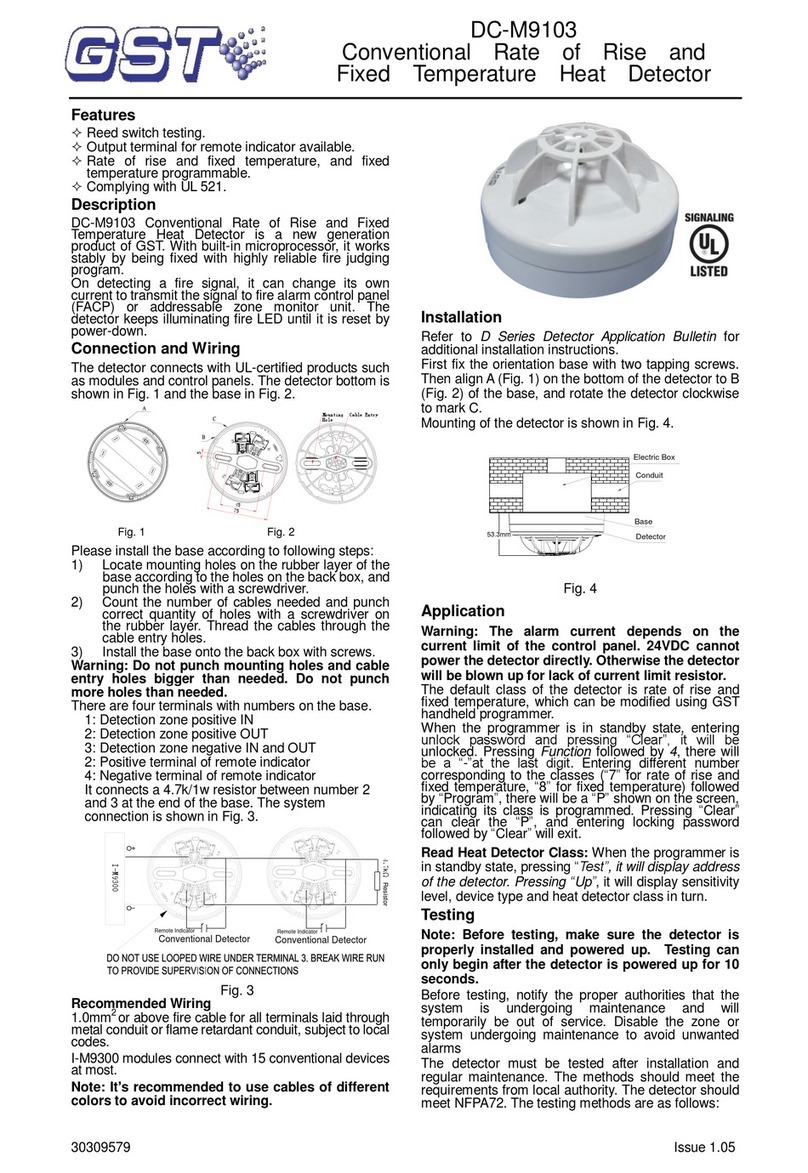
30309742Issue 1.01
Features
With novel structure, attractive appearance, stable and
reliable performance, the detector is especially
applicable to places where fire occurs with sharp rise of
temperature. Used together with smoke detectors, it can
detect fire with more reliability to reduce losses and
chemical corrosion proof.
Description
DC-9103(IS) Intrinsically Safe Conventional Rate of Rise
and Fixed Temperature Heat Detector is applicable to
zone 1 and zone 2 of areas with explosion-proof
requirement in petroleum, chemical industries and ships.
Used together with I-9332 interface, it can be connected
with compatible FACP (fire alarm control panel) to
process fire alarm signals.
The detector has two classes: A1R and BS. They can be
set through an programmer on site.
Connection & Wiring
Warning: Installation must strictly comply with the
relative explosion-proof code.
Mounting of the detector is shownin Fig. 1.
Detector
Base
Conduit
Back Box
Fig.1
Bottom and DB-01(IS) base are shown in Fig. 2 and Fig.3
Fig. 2 Fig. 3
The explosion-proof base of the detector is shown in Fig.
3. First secure the detector base with two tapping screws,
and then connects the DC power supply cable of the
detector and the positive end of power output cable to
Terminal No. 1, 3 and 2 of the base. Please note to
connect Terminal No. 1 to the positive of power supply
and Terminal No. 3 to negative. Terminal No. 2 connects
with positive power output cable; Terminal No. 4 doesn’t
connect to any cable.
There are two marks B and C on the orientation base,
and mark Aon the detector bottom. Aligning mark Ato B
of the base, and rotating the detector clockwise to mark
C, the detector will be installed onto the base. Refer to
Fig. 2 and Fig. 3.
Wiring:
1.0mm2or above intrinsically safe cable is
recommended. Make sure distributed capacitance
among cables is not over 0.083F, and distributed
inductance not over 4.1mH.
Note: Please use cables of different colors to avoid
possible confusion.
Operation
Set Class of the Detector
When the programmer is in standby state, entering
unlock password and pressing “Clear”, it will be
unlocked. Pressing Function followed by 4, there will be
a “-”at the last digit. Entering different number
corresponding to the classes (“2”for A1R, “1”for BS)
followed by “Program”, there will be a “P”shown on the
screen, indicating its class is programmed. Pressing
“Clear”can return, and entering locking password
followed by “Clear”will exit. If there will be an “E”
shown on the screen, indicate it is fail to program.
Press Clear and program again.
Table 1
1. After installation and connection of the system, turn
on the FACP and enter commissioning state. Check if all
interfaces are registered. If not, take down the number of
the unregistered ones and check the problem.
2. After all interfaces and detectors are registered,
making the system into normal standby state, there
should be no fault or alarm from detectors.
3. After system commissioning, please do fire test.
Fire simulation test: in normal state, heat the
temperature sensitive component using blower fan, and
the detector should send fire signal and light the alarm
LED. Press “Clear” on the fire alarm control panel when
the temperature is decrease, the system returns to
normal state.
Note: To ensure every detector works normally,
please make sure the base connection is correct.
The methodis as follows: power up the detector, and
measure the voltage between terminals. There
should be 24VDC between Terminal “1” and “3”. “1”
should be positive and “3”should be negative.
DC-9103(IS) Intrinsically Safe
Conventional Rate of Rise and Fixed
Temperature Heat Detector




















